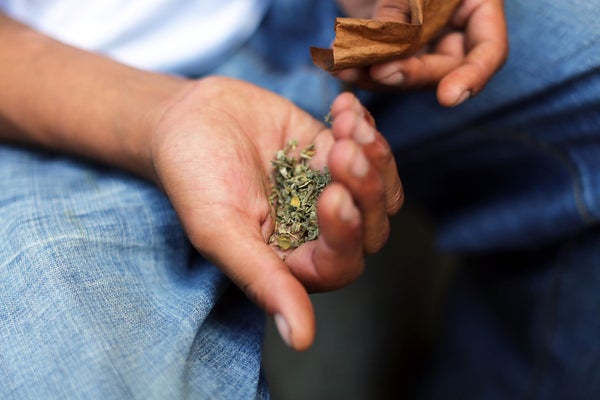Three people died and more than 100 have been sickened in the past few weeks after taking synthetic cannabinoids, human-made compounds that target the same brain receptors as marijuana. Symptoms documented by poison centers—first mostly in the Midwest, and now in Maryland—include unexplained bruising, coughing up blood, bleeding from the nose and gums, blood in urine and feces, and excessively heavy menstruation.
An ongoing investigation has identified a likely culprit in the blood of those affected: rat poison, specifically brodifacoum. Commonly sold in hardware stores, it is a dangerous anticoagulant that can also cause brain damage.
These are the first known instances of rat poison being found in synthetic cannabinoids—and how the toxin got there is unknown. Douglas Feinstein, a neuroscientist and brodifacoum expert developing new antidotes to this substance at the University of Illinois at Chicago, says the symptoms in these cases indicate high levels of exposure. That makes accidental contamination unlikely, he says, and suggests the poison may have been introduced deliberately. “We don’t know the exact doses these people are getting, but it’s a lot,” says Feinstein, who is hoping to analyze blood samples from those affected.* “It could have been added intentionally to prolong the high.”
On supporting science journalism
If you're enjoying this article, consider supporting our award-winning journalism by subscribing. By purchasing a subscription you are helping to ensure the future of impactful stories about the discoveries and ideas shaping our world today.
That may seem like the stuff of urban legends. But Feinstein cites previous case studies, reported in the scientific literature, of drug users deliberately ingesting rat poison to stay high longer when taking marijuana or cocaine. The toxin ties up liver enzymes that metabolize drugs, extending their effects.
Feinstein—whose work is funded by the National Institutes of Neurological Disorders and Stroke’s CounterACT Program, tasked with developing countermeasures against chemical threats—added that malicious intent cannot be ruled out. He also speculated the drugs themselves could have exacerbated the poisoning if they dilated blood vessels.
Little is known about what synthetic cannabinoids themselves do to the body. Many of these compounds were developed experimentally in the 1980s by scientists studying the brain and trying to develop new analgesics. The ones now found in the U.S. are often made in China, and can be purchased online. Known by a wide variety of names including “Spice” and “K2,” they are typically sprayed on various herbs and sold as a smoking mixture, sometimes labeled as incense.
Authorities have arrested a convenience store owner in Chicago for allegedly selling some of the contaminated material linked to the current poisoning outbreak. Bruce Anderson, executive director of the Maryland Poison Center, says he was told the poisoned Maryland resident purchased the product that made them ill “at a local store.” He warns these substances are poorly understood, and can be perilous even when not tainted; the new cases comprise the latest chapter in an ongoing public health crisis, as people increasingly chase a buzz from numerous chemicals developed for scientific research and readily available on the internet or dark web. “None of these products have ever been tested on humans,” Anderson notes. “Using them is a spectacularly bad idea.”
Typically cheap and invisible to traditional drug screening, synthetic cannabinoids have been especially popular among the poor and incarcerated. A 2014 study flagged these chemicals as a popular drug of choice among military personnel dealing with substance abuse.
Poison control centers receive thousands of calls about synthetic cannabinoids every year, and they usually have nothing to do with rat poison. Emergency room doctors have documented a confusing array of problems among users: seizures, strokes, brain bleeding and heart attacks. In 2016 several dozen New Yorkers wound up in hospitals, unresponsive to the outside world, after reportedly using these drugs. Earlier this year dozens of U.S. soldiers and Marines were hospitalized after allegedly vaping synthetic cannabinoid oil. “The side-effect profile of these compounds is unknown,” says William Burgin, a neurologist and professor at the University of South Florida. “It’s bag of nightmares for those dealing with patients on the frontlines.”
Tetrahydrocannabinol (THC), the main psychoactive ingredient in cannabis, binds to cannabinoid receptors in the brain and body rather weakly, Burgin says. But some molecules in the synthetic chemicals hold on with an iron grip; they can be hundreds of times more potent than natural pot. Their chemical structures often bear little resemblance to THC, and that is part of what makes them difficult to regulate. In 2011 the U.S. Drug Enforcement Agency banned five of the earliest such compounds to hit the streets, and in 2012 Congress passed the Synthetic Drug Abuse Prevention Act outlawing 15 chemicals. Makers responded with creative chemistry, crafting other molecules that have similar effects and thus staying one step ahead of the law, says Jeff Lapoint, director of the Division of Medical Toxicology at Kaiser Permanente San Diego Medical Center. The exact formula in the drugs recently found to be tainted with rat poison remains unclear.
“It’s like a game of Whac-A-Mole: Make one thing illegal, and the next week something new pops up,” Lapoint says. Authorities at the state level are also trying to crack down. But this is “happening in a piecemeal fashion and varies from state to state,” says Stefanie Jones, director of audience development at the Drug Policy Alliance, a nonprofit organization that advocates for drug law reform.
Lapoint says he has purchased packets of these drugs and analyzed their contents. The compounds he found within varied wildly, and he says those who choose to use them can never really have any idea what they might be putting into their bodies. “It’s like playing Russian roulette,” he says. “You don’t know what you’re getting or how much you’re getting or what these chemicals will do.”
*Editor's Note (4/17/18): This sentence was edited after posting. The original erroneously stated Feinstein is currently analyzing blood samples from those affected.
